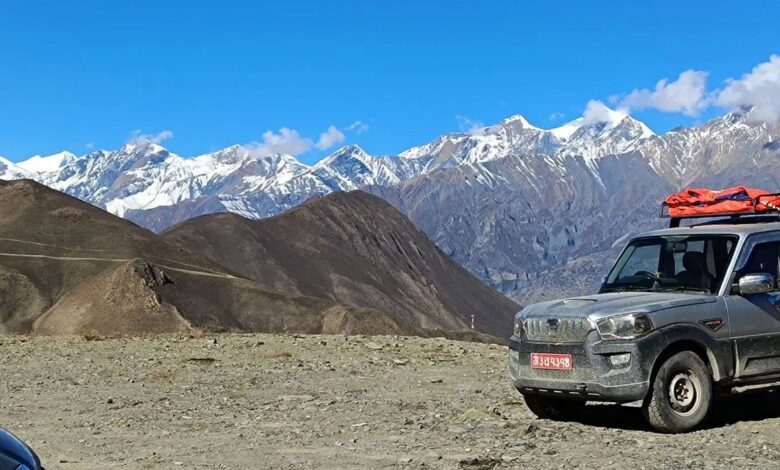Annapurna Circuit Trek In October

In October, the Annapurna Circuit Trek in Nepal offers an ideal balance of favorable weather conditions, stunning scenery, and cultural experiences. As the post-monsoon season transitions into autumn, trekkers can expect clear skies, mild temperatures, and vibrant landscapes adorned with blooming rhododendrons and lush vegetation. The trek typically begins in Besisahar and winds through diverse terrain, from terraced fields and subtropical forests to alpine meadows and barren high-altitude deserts.
October marks the tail end of the peak trekking season in Nepal, ensuring well-maintained trails and accessible teahouses with fewer crowds compared to earlier months. This allows for a more tranquil and immersive trekking experience amidst the Himalayan peaks. Accommodation options along the route range from basic teahouses offering communal dining and shared facilities to more comfortable lodges in popular villages like Manang and Jomsom, providing private rooms and hot showers.
Cultural encounters enrich the journey as trekkers pass through traditional villages inhabited by diverse ethnic groups such as Gurungs, Thakalis, and Manangis. These communities offer insight into their unique lifestyles, traditions, and religious practices, including visits to ancient monasteries and temples.
The highlight of the Annapurna Circuit Trek in October is crossing Thorong La Pass at 5,416 meters (17,769 feet), offering panoramic views of snow-capped peaks including Annapurna and Dhaulagiri. The challenging ascent to the pass is rewarded with breathtaking vistas and a sense of achievement.
Safety considerations in October include preparing for colder nights at higher elevations and the possibility of occasional showers. Trekkers are advised to pack warm clothing layers, a reliable sleeping bag, waterproof gear, and sturdy hiking boots. Hydration and proper acclimatization remain crucial, with ample opportunities for rest and acclimatization in villages like Manang and Pisang.
Overall, October presents an optimal window for experiencing the Annapurna Circuit Trek, combining comfortable weather conditions, scenic beauty, cultural immersion, and the challenge of crossing one of the world’s highest mountain passes. It’s a time when Nepal’s natural splendor is at its peak, making it a memorable adventure for trekkers seeking both physical challenge and spiritual rejuvenation amidst the Himalayas.
Introduction to Annapurna Circuit Trek
The Short Annapurna Circuit Trek stands as a quintessential journey through the majestic Himalayas of Nepal, renowned for its diverse landscapes, cultural richness, and awe-inspiring mountain views. Spanning approximately 160-230 kilometers (100-145 miles), this iconic trek takes adventurers through lush forests, picturesque villages inhabited by diverse ethnic groups, and high-altitude desert terrain. The pinnacle of the trek is crossing Thorong La Pass at 5,416 meters (17,769 feet), offering panoramic vistas of the Annapurna and Dhaulagiri ranges that leave an indelible impression on trekkers.
Benefits of Trekking in October
October is widely regarded as one of the best times to embark on the Annapurna Circuit Trek due to its optimal weather conditions. As the post-monsoon season transitions into autumn, trekkers can enjoy clear skies, mild daytime temperatures ranging from 10°C to 20°C (50°F to 68°F) at lower elevations, and stunning views of blooming rhododendrons and vibrant landscapes. The trails are well-maintained, offering a pleasant trekking experience with fewer crowds compared to peak seasons, allowing for more serene and immersive moments amidst Nepal’s natural splendor.
Weather Conditions in October
October presents favorable weather conditions for trekking the Annapurna Circuit. Days are generally sunny with clear skies, providing excellent visibility of the surrounding mountain peaks. Nights can be chilly, especially at higher altitudes, with temperatures ranging from -5°C to 5°C (23°F to 41°F). Occasional brief showers may occur, particularly in the early part of the month, so it’s advisable to pack waterproof layers and be prepared for variable weather conditions throughout the trek.
Required Permits and Fees
To trek the Annapurna Circuit, several permits are required. The main permits include the Annapurna Conservation Area Permit (ACAP) and the Trekkers’ Information Management System (TIMS) card. These permits can be obtained from the Nepal Tourism Board office in Kathmandu or from the checkpoint offices along the trekking route. The costs vary depending on the season and nationality of the trekker. It’s essential to carry multiple copies of these permits as they may be required for various checkpoints along the route.
Packing List for October Trekking
Packing wisely is crucial for a comfortable and safe trekking experience in October. Essential items include sturdy hiking boots with good ankle support, moisture-wicking clothing layers for varying temperatures, a warm insulated jacket, waterproof and windproof outer layers, a sleeping bag suitable for cold temperatures, a headlamp or flashlight, sunglasses, sunscreen, and a refillable water bottle with water purification tablets or a filtering system. Additionally, carry a basic first aid kit, toiletries, snacks, and trekking poles for stability on uneven terrain.
FOR MORE INFORMATION CLICK HERE : driving experience supercars
Best Accommodation Options Along the Route
Accommodation along the Annapurna Circuit varies from basic teahouses (lodges) to more comfortable lodges and guesthouses in popular villages such as Manang and Jomsom. Teahouses typically offer communal dining areas and shared bathroom facilities, while more established lodges may provide private rooms with attached bathrooms and amenities like hot showers and Wi-Fi in some places. Accommodation prices generally increase with altitude due to the logistical challenges of supplying goods to higher elevations. It’s advisable to carry cash (Nepalese Rupees) as ATMs are not readily available in remote areas, and book accommodation early during peak trekking seasons like October to secure preferred lodging options along the route.
Food and Water Safety Tips
Maintaining food and water safety is crucial while trekking the Annapurna Circuit to prevent gastrointestinal illnesses. Stick to freshly prepared meals in teahouses and avoid raw or undercooked foods. The staple dish, dal bhat (rice and lentils), is a safe and nutritious option. Ensure water is either boiled, treated with water purification tablets, or filtered to avoid waterborne diseases. It’s wise to carry your own refillable water bottle and purifying equipment throughout the trek. Additionally, practice good hand hygiene by washing hands with soap and water or using hand sanitizer before eating.
Physical Fitness Preparation
Preparing physically for the Annapurna Circuit trek is essential due to its challenging terrain and high altitudes. Start training well in advance with cardiovascular exercises like hiking, jogging, or cycling to improve endurance. Strength training focusing on leg muscles (quadriceps, hamstrings, calves) helps with uphill climbs and descents. Flexibility exercises such as yoga or stretching enhance muscle elasticity and joint mobility, reducing the risk of injuries. Gradual acclimatization is critical during the trek, starting with shorter hikes and progressively increasing elevation gain to simulate trekking conditions.
Altitude Sickness Prevention
Altitude sickness, or acute mountain sickness (AMS), can affect trekkers ascending to high altitudes too quickly. Symptoms include headaches, nausea, dizziness, and fatigue. To prevent AMS, ascend slowly, allowing time for acclimatization. Spend at least two nights at locations above 3,000 meters (9,800 feet) before proceeding to higher altitudes. Stay well-hydrated by drinking plenty of fluids and avoid alcohol and caffeine, which can contribute to dehydration. Eat light, high-carbohydrate meals that are easy to digest. Carry medications like acetazolamide (Diamox) under medical guidance to help prevent and alleviate AMS symptoms.
Trekking Routes and Itinerary Suggestions
The Annapurna Circuit offers various route options, each with unique highlights and challenges. A classic itinerary starts from Besisahar and progresses through villages like Chamje, Manang, and Thorong Phedi before crossing Thorong La Pass. After descending, continue through places like Muktinath, Marpha, and Tatopani, concluding in Nayapul or Jomsom. Shortened versions skip sections using local transportation to key points along the route. Extensions include side trips to Tilicho Lake or exploring the Upper Mustang region. Consult experienced guides or trekking agencies to tailor an itinerary matching fitness levels and time constraints.
Highlights of the Annapurna Circuit Trek
The Annapurna Circuit trek is renowned for its spectacular natural beauty and cultural diversity. Highlights include crossing Thorong La Pass at 5,416 meters (17,769 feet), providing breathtaking views of the Annapurna and Dhaulagiri ranges. The trek encompasses diverse landscapes from lush forests and terraced fields to arid deserts and alpine meadows. Cultural experiences abound in traditional villages inhabited by Gurungs, Thakalis, and Manangis, showcasing unique architecture, monasteries, and festivals. Natural wonders include Tilicho Lake, one of the highest lakes in the world, and serene hot springs at Tatopani. The journey offers a blend of physical challenge and spiritual rejuvenation amidst Nepal’s Himalayan splendor.
Cultural Experiences Along the Trail
The Annapurna Circuit trek offers rich cultural encounters as trekkers pass through diverse villages inhabited by ethnic communities such as Gurungs, Thakalis, and Manangis. These communities maintain traditional lifestyles, evident in their architecture, dress, and religious practices. Monasteries and temples along the route provide insights into Buddhism and Hinduism, with opportunities to observe rituals and ceremonies. Cultural evenings often feature traditional music and dance performances, allowing trekkers to immerse themselves in local folklore. Respect for local customs, such as removing shoes before entering homes or religious sites, enhances cultural exchange and mutual appreciation during the journey.
Wildlife and Nature Encounters
The Annapurna Circuit trek traverses through varied ecosystems, offering opportunities to encounter diverse wildlife and natural beauty. In lower elevations, lush forests are home to species like langur monkeys, deer, and various bird species. As the trek ascends, alpine meadows bloom with colorful rhododendrons and other wildflowers. Higher altitudes reveal hardy alpine vegetation, and fortunate trekkers may spot elusive Himalayan wildlife such as snow leopards and blue sheep. The region is also renowned for its diverse birdlife, including eagles, vultures, and Himalayan monals, adding to the natural splendor of the trekking experience.
Safety Tips for October Trekking
Trekking the Annapurna Circuit in October requires careful preparation to ensure safety and enjoyment. While the weather is generally favorable with clear skies and mild temperatures, trekkers should be prepared for occasional showers and colder nights at higher altitudes. Pack appropriate clothing layers including a warm jacket, waterproof and windproof outer layers, and sturdy hiking boots. Stay hydrated by drinking plenty of water throughout the trek and avoid alcohol and caffeine, which can contribute to dehydration and altitude-related symptoms. Familiarize yourself with the symptoms of altitude sickness and know when and how to seek medical assistance if needed. Carry a well-equipped first aid kit and register with local trekking agencies to facilitate emergency response coordination if necessary.
Emergency Procedures and Contacts
In case of emergencies during the Annapurna Circuit trek in October, knowing local emergency contacts and procedures is crucial. Carry a fully charged mobile phone and have a list of emergency contacts including local authorities, trekking agencies, and medical facilities. Register with the Trekkers’ Information Management System (TIMS) to facilitate emergency response coordination. Teahouse owners and local guides can often provide basic first aid, while serious emergencies may require evacuation by helicopter to Kathmandu or Pokhara. Ensure travel insurance covers trekking activities in Nepal, including emergency evacuation and medical expenses, to mitigate financial risks associated with emergencies.
Best Photo Spots on the Trek
The Annapurna Circuit trek offers numerous picturesque photo opportunities that capture the essence of Nepal’s Himalayan beauty and cultural diversity. Some of the best photo spots include:
Thorong La Pass: Capture panoramic views of snow-capped peaks including Annapurna and Dhaulagiri.
Tilicho Lake: One of the highest lakes in the world, surrounded by rugged mountain terrain.
Kagbeni: A medieval village with traditional mud-brick houses against the backdrop of Nilgiri and Tukuche peaks.
Poon Hill: Known for stunning sunrise views of the Annapurna and Dhaulagiri ranges, adorned with prayer flags.
Each spot offers a unique perspective on the landscape and cultural richness of the Annapurna region, making it a photographer’s paradise.
Sustainable Trekking Practices
Practicing sustainable trekking is essential to minimize environmental impact and support local communities along the Annapurna Circuit. Some sustainable practices include:
Leave No Trace: Pack out all waste, including biodegradable items like food scraps.
Support Local Economy: Stay in locally owned teahouses and purchase meals made from locally sourced ingredients.
Respect Culture and Wildlife: Observe wildlife from a distance and respect cultural sites by following local customs and guidelines.
Minimize Water Usage: Conserve water by taking short showers and using water purification methods rather than buying bottled water.
Choose Responsible Tour Operators: Select trekking agencies that prioritize sustainability and employ local guides and porters under fair working conditions.
By adopting sustainable practices, trekkers can help preserve the natural beauty and cultural heritage of the Annapurna Circuit for future generations to enjoy.
Recommended Gear for October Trekking
Packing the right gear for trekking the Annapurna Circuit in October ensures comfort and safety amidst varied weather conditions. Essential items include sturdy hiking boots with good ankle support and waterproofing to navigate rocky trails and occasional mud. Layer clothing for versatility, including moisture-wicking base layers, insulating mid-layers, and a windproof and waterproof outer shell. Pack a warm insulated jacket for colder mornings and evenings at higher elevations, along with thermal underwear and gloves. A reliable sleeping bag rated for low temperatures ensures restful nights in teahouses or campsites. Other essentials include a headlamp or flashlight for early morning starts or late arrivals, sunglasses, sunscreen, and a refillable water bottle with water purification tablets or a filtering system. Additionally, carry a basic first aid kit, toiletries, snacks, and trekking poles for stability on uneven terrain.
Local Guides and Porters Information
Local guides and porters play integral roles in supporting trekkers along the Annapurna Circuit, providing valuable knowledge of the terrain, culture, and safety. Guides are well-versed in local trails, weather patterns, and emergency procedures, enhancing the trekking experience with their expertise. They facilitate cultural exchanges by interpreting local customs, traditions, and historical sites. Porters carry trekking gear and supplies, allowing trekkers to focus on enjoying the journey without the burden of heavy loads. Hiring local guides and porters not only supports the local economy but also ensures fair working conditions and proper equipment. It’s advisable to engage guides and porters through reputable trekking agencies that prioritize their welfare and provide insurance coverage.
Post-Trek Recovery and Reflections
After completing the Annapurna Circuit trek in October, prioritizing post-trek recovery enhances physical and mental well-being. Allow time for rest and relaxation to recuperate from physical exertion and altitude effects. Hydrate and refuel with nutritious meals rich in carbohydrates, proteins, and vitamins to replenish energy stores. Gentle stretching or yoga improves flexibility and reduces muscle soreness. Reflect on the trekking experience, journaling about challenges overcome, memorable encounters, and personal achievements. Share stories and experiences with fellow trekkers to gain insights and perspectives. Celebrate the journey with a meal or cultural experience in Kathmandu or Pokhara before departing, acknowledging the transformative impact of trekking amidst Nepal’s Himalayan splendor.
Comparison with Other Trekking Seasons
October stands out as one of the best months for trekking the Annapurna Circuit, offering optimal weather conditions and scenic beauty. Compared to peak seasons like spring (March to May), October features fewer crowds on the trails while maintaining well-maintained routes and accessible teahouses. Clear skies provide excellent visibility of the surrounding mountain peaks, enhancing the trekking experience with panoramic views and vibrant landscapes. The post-monsoon season ensures lush vegetation, blooming rhododendrons, and moderate temperatures ideal for trekking. While occasional showers and colder nights at higher altitudes require preparation, October strikes a balance between favorable weather, cultural experiences, and physical challenge, making it a preferred choice for trekkers seeking both adventure and tranquility in Nepal’s Himalayas.
Conclusion: Recap of the Annapurna Circuit Trek Experience in October
Trekking the Annapurna Circuit in October offers an unforgettable adventure through Nepal’s diverse landscapes and cultural tapestry. The month’s favorable weather conditions, clear skies, and moderate temperatures create an ideal setting for exploring the Himalayan terrain. Highlights include crossing Thorong La Pass, with its breathtaking mountain vistas, and encountering traditional villages inhabited by diverse ethnic communities. Cultural experiences enrich the journey, from visiting ancient monasteries to witnessing local festivals and rituals. The trek’s physical challenges are rewarded with natural wonders such as Tilicho Lake and serene hot springs. Engaging local guides and porters enhances the trekking experience, ensuring safety and cultural immersion. Post-trek reflections provide opportunities for personal growth and appreciation of the journey’s significance. October’s allure lies in its balance of adventure and tranquility, making it a prime season for experiencing the Annapurna Circuit’s beauty and spiritual rejuvenation amidst Nepal’s majestic Himalayas.





